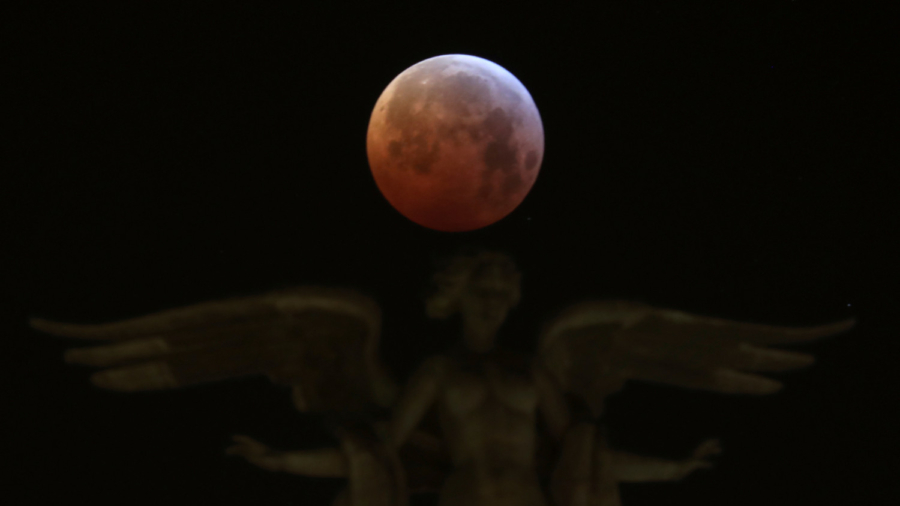During a lunar eclipse at the beginning of 2019, a meteorite zoomed by and smacked the moon in the face, researchers have said.
On Jan. 21, moments after the moon entered into the total lunar eclipse, a meteorite hit the red-hued moon, which caused a brief and bright flash of light that was visible to people across the northern hemisphere, according to Live Science. The flash of light caught the attention of amateur astronomers as the moon was eclipsed by the earth and shrouded in darkness.
Witnessing impacts like this are extremely rare given their unpredictability. Many objects impact the moon every year, but they’re not always seen.
During the lunar eclipse, not only were amateur astronomers watching, but the professional astronomers were also observing the moon and witnessed the quick burst of light from the meteorite collision. Researchers studied the moon through a number of telescopes in southern Spain—eight, in fact. After careful observation and reviewing of the impact footage, researchers might have figured out just how hard the moon was hit and what exactly had collided with it during the lunar eclipse.
According to a monthly notice from the Royal Astronomical Society (pdf), the item that the researchers found to have impacted the moon was likely a rogue meteoroid weighing roughly 100 pounds, having a diameter of ranging from 1 to 2 feet, depending on the type of materials the meteoroid was made of. It was traveling at a speed of 38,000 miles per hour—that’s more than 600 times faster than the speed of a running cheetah. At that speed, the impact would have left a mark around 50 feet in diameter on the moon’s surface.
These estimated were derived from examining the duration of the flash, which allowed them to determine the temperature of the meteoroid as it impacted the moon with the assistance of the Moon Impacts Detection and Analysis System. The system estimated that the meteoroid was around 10,000 degrees Fahrenheit, roughly the same temperature as the surface of the sun, upon impact. By figuring out the temperature and the duration of the flash, they were able to estimate the speed, size, and weight of the meteoroid.
According to the report, the researchers estimated that the force of the impact was equal to setting off 1.65 tons of dynamite on the moon.
However, as impressive as the large numbers are, the moon is no stranger to collisions and impacts that leave long-lasting marks and craters on its surface. In fact, about 140 new craters measuring at least 33 feet appear on the moon’s uneven surface every year. Due to the absence of an atmosphere, an object of any size traveling at that kind of speed would leave a significant impact on the surface. However, these impacts and craters aren’t easily seen from the earth due to the sun being too bright, even for the astronomers.
More Meteorites
An apparent meteorite landed in western Cuba on Feb. 1, according to reports and photos published on social media.
The National Weather Service in Key West said a meteor was seen in the sky over the Florida Keys.
“We’re receiving reports that a meteor was seen in the sky across the Florida Keys,” the agency’s office wrote on Twitter. “It appears that a meteorite impact occurred in western Cuba, near the town of Vinales, Pinar del Rio, earlier this afternoon.”
#BREAKING: Just got this video from a friend in #PinardelRio who says they think the trail in the sky was left by a #meteorite, which shattered windows and made extremely loud sounds. Sounded like two #explosions. #cuba @WPLGLocal10 pic.twitter.com/AMmb9ZE6vB
— Hatzel Vela (@HatzelVelaWPLG) February 1, 2019
Local 10 Cuba correspondent Hatzel Vela obtained video footage which is believed to be a sky trial left by the alleged meteorite.
The meteorite also “shattered windows and sounded like two explosions,” Local 10 reported.
It’s not clear if there were reports of damage or injuries.
Cuban newspaper Juventud Rebelde said there was “a strong explosion” near Pinar del Rio, NBC6 reported.
Only in Cuba does an apparent meteorite crash and you happen to know the person who’s house was hit. pic.twitter.com/jYhAnBLUy0
— Patrick Oppmann CNN (@CNN_Oppmann) February 1, 2019
Epoch Times reporter Jack Phillips contributed to this article.


